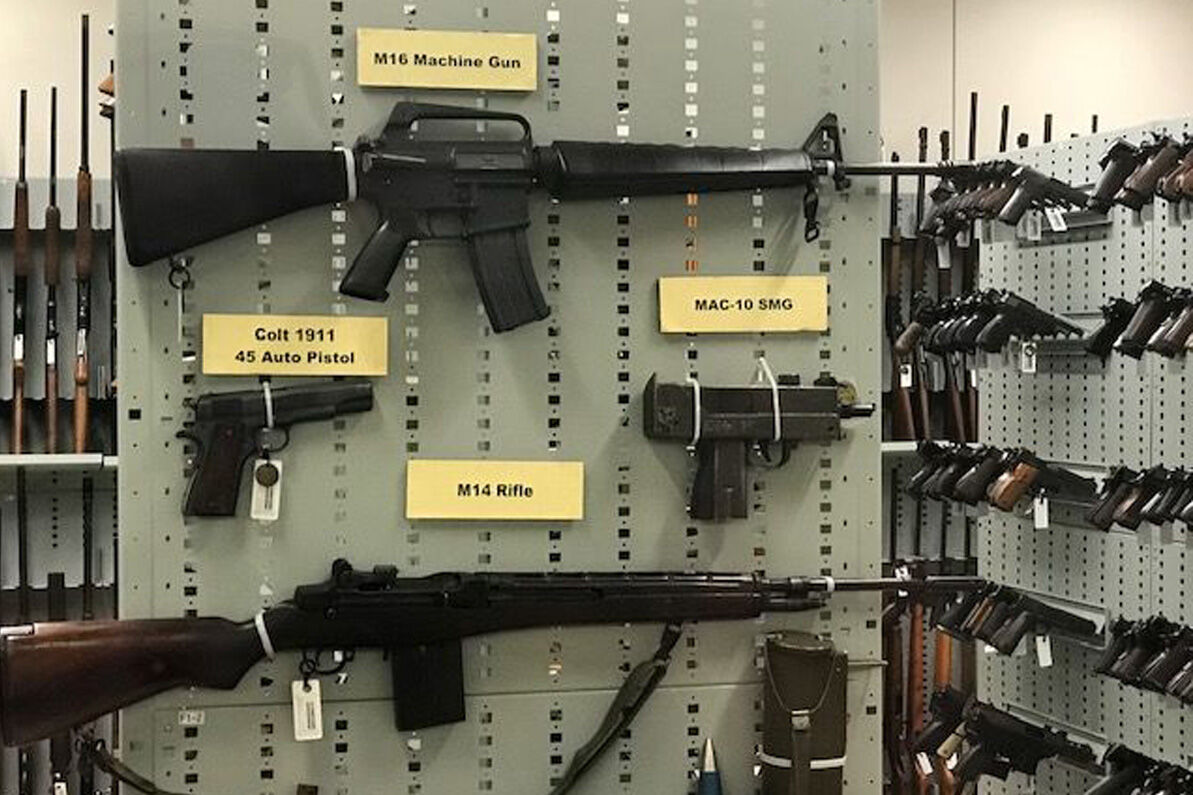The D.C. Department of Forensic Sciences is under criminal investigation amid allegations that managers at the independent lab pressured analysts to change their conclusions, and then potentially misrepresented findings to its accrediting body, all in an attempt to essentially paper-over a years-old error that mistakenly linked two killings to the same gun.
The criminal probe is being conducted by the D.C. Office of the Inspector General. It comes as an outside team of experts retained by federal prosecutors to review some of the lab’s casework said the department’s firearms unit should immediately cease its casework, citing “very serious” problems with lab management that have “cast doubt on the reliability of the work product of the entire DFS laboratory.”
The allegations against the D.C. crime lab managers, and the existence of the criminal investigation, are revealed in documents filed in D.C. Superior Court earlier this week. Acting U.S. Attorney for D.C. Channing Phillips is seeking an immediate hearing before Judge Milton C. Lee Jr. on the matter.
Last year, the U.S. Attorney’s Office for D.C. and the Office of the Attorney General launched an outside review of cases handled by the lab’s firearms unit after the discovery of the botched 2017 analysis that linked cartridge casings from two different murders.
The defendant at the center of one of those cases, Rondell McLeod, is set to stand trial in June on murder charges, and has sought for months to have the indictment dismissed, citing the faulty analysis.
WTOP first reported last fall that prosecutors had retained the outside “audit team,” made up of some of the top forensic firearms experts in the country, to review the D.C. lab’s firearms casework.
Unlike many crime labs across the country, which are situated within law enforcement agencies, D.C.’s is an independent agency, with a director appointed by D.C. Mayor Muriel Bowser. The lab is responsible for analyzing evidence from crime scenes, including guns, DNA and fingerprints.
The new court filings appear to show more serious allegations of wrongdoing than have been previously reported.
They include allegations that firearms unit managers pressured their examiners who looked into the 2017 error to ultimately reach an “inconclusive” finding in the case — meaning that the lab couldn’t say with certainty whether the casings were a match or not — and then buried an earlier review by a lab supervisor that had correctly determined the shell casings were not fired from the same gun.
The final report from the prosecutors’ audit team, which is included in the new court filing, said the team “does not have confidence in the analytical results” of the firearms unit, known as the FEU. “The audit team recommends that the FEU immediately cease performing casework and that clients and stakeholders not rely on results from the FEU.”
The audit report said all examiners currently employed by the unit need to be evaluated for technical competence.
“Casework already completed by the FEU should be reexamined by qualified examiners in an effort to determine if additional errors have been made,” the report said.

The report also said it uncovered “very serious, and perhaps more troubling, problems associated with DFS management,” and that management at the agency “not only failed to properly address the conflicting results” uncovered by the prosecutors’ audit team “but also engaged in actions to alter the results reached by examiners assigned to conduct a reexamination of the evidence.”
DFS response
The newly-filed documents include the final report from the prosecutors’ audit team, dated March 18, and summaries of interviews of DFS employees, as well as documents the lab was ordered to turn over by a D.C. judge last year after an unprecedented subpoena by prosecutors.
The D.C. inspector general’s criminal probe began in early December, according to the new filing, after they were referred by the D.C. attorney general’s office. Investigators have been interviewing DFS employees as recently as this month.
A representative for the inspector general’s office told WTOP in an email she could not comment on investigative matters.
In response to an emailed list of questions from WTOP about the latest court filing, Jenifer Smith, the director of the D.C. Department of Forensic Sciences, did not address the inspector general’s investigation or allegations of managers pressuring employees about their findings, but provided a written statement regarding the ongoing work of the prosecutors’ audit team.
“By statute, Department of Forensic Sciences must remain independent from the prosecution and defense,” Smith said. “Forensic testing complaints are required to be reviewed by the independent Science Advisory Board (SAB), and audits are required to be performed by a third-party national accrediting body (ANAB). The review conducted by the Office of the Attorney General (OAG) and the U.S. Attorney’s Office (USAO) does not meet this criteria and cannot be considered an audit of the department. The SAB has requested the materials reviewed by the USAO and OAG for this report and these materials have yet to be made available.”
Smith told WTOP in an interview last fall — and, more recently, during a Scientific Advisory Board meeting in January — that ANAB (the American National Standards Institute’s National Accreditation Board) inspected the firearms unit last summer and also investigated prosecutors’ claims. In the end, the accrediting body gave the lab a clean bill of health, re-accrediting the lab and closing all complaints raised by prosecutors.
Pamela Sale, vice president of forensics for ANAB, told the Scientific Advisory Board during the January meeting that, as part of its reviews of the lab, two of the group’s auditors had reviewed the DFS case notes for the “inconclusive” finding and found that the case notes supported that conclusion. She also said, however, that ANAB auditors had reviewed the case notes of the prosecution’s outside experts and found that those notes supported their conclusion that the casings were not fired in the same gun.
“I think we’re probably all fairly familiar with the experience of being in a courtroom and having someone testify on the other side, and there’s quite frequently a difference of opinion,” Sale told the panel. “That’s just the nature of our legal system.”
When asked by Smith before the panel if ANAB has “any hesitation about the quality of the work that’s coming out of this laboratory,” Sale responded: “No,” adding, “Based on our two recent activities last year, we’re confident that the work that the laboratory is putting out — you’re following your protocol, you’re meeting accreditation requirements.”
Long-running dispute
The lab and federal prosecutors in D.C. have been locked in an acrimonious dispute over the handling of firearms evidence for more than a year.
In the case involving the botched analysis of cartridge casings, DFS was slow to acknowledge the error, but eventually admitted its mistake, blamed an administrative error and said the lab’s new official finding — which came after a reexamination of the evidence — was “inconclusive.”
That still conflicted with the findings of the prosecutors’ audit team, which said multiple outside experts had examined the same shell casings and found enough evidence to rule out the idea that the casings were fired by the same gun. That’s known as an “elimination” finding.
The lab stood by its new official conclusion and Smith, the DFS director, said in an interview with WTOP last fall that the differing findings between her lab and the outside examiners fell into a “gray area” common to forensic science, and that her lab was simply more conservative in determining matches.
But according to the new documents, there appeared to be a concerted effort by management to reach that “inconclusive” determination — apparently amid fears that reversing the agency’s finding entirely would look like the lab had made a mistake.
As detailed in the new documents, when the lab was first notified of the 2017 error, two lab employees, including the supervisor in the firearms unit, Jonathan Fried, reexamined the casings under a microscope. They concluded that the casings were not fired by the same gun — a reversal of the lab’s original 2017 conclusion — which put them in agreement with the prosecutors’ outside review.
However, those findings were not set down in an official report. They were instead presented in a PowerPoint presentation to senior management in the firearms unit in late April.
According to the documents, Fried later told investigators that managers in the unit — including Fried’s superiors, FEU manager Jonathan Pope and Forensic Science Laboratory Director Wayne Arendse — were concerned the reversed conclusion would make it look like the lab had made a mistake.
Eventually, a decision was made by managers — including Pope and Arendse — to change the result of the analysis to “inconclusive,” in part because of the various conflicting findings reported by DFS examiners, according to the documents. Another employee interviewed by the inspector general’s office said an inconclusive finding was a “safer answer” because “you can’t be wrong.”
‘A nearly impossible situation’
Perhaps most damning, the documents allege that Arendse, one of the top lab officials, sent an email to ANAB on May 6 — less than a week after Fried gave his PowerPoint presentation — suggesting Fried, identified in the email as “the FEU Supervisor,” had reached a finding of inconclusive when, in fact, his earlier presentation had specifically ruled out a match.
It was only several days after the email to the accrediting body that Fried said he was actually asked to perform an official reexamination of the evidence, a review that would be documented in the lab’s records.
Fried told investigators he felt he was inherently biased because he knew of all the conflicting conclusions that had been reached, and asked for an outside reviewer to take another look at the cartridge casings. He said he “pushed back as long as I could,” but the request was denied and he was told by Pope, the unit’s manager, that the request for him to carry out the reexamination came from Smith, the DFS director.
When it came time for Fried, the supervisor, to conduct the formal reexamination, he said he was never specifically told to change his finding to inconclusive, but he relayed to investigators that he felt manipulated by managers into conducting an examination when he had a bias, and that the other examiners’ conflicting findings caused him to question his initial conclusion that the casings were not a match. He told investigators that if he had to do it over again, he would have resigned rather than carry out the reexamination.
In the end, his report of examination on the long-disputed shell casings — issued May 27 — listed an official finding of inconclusive.
The prosecutors’ audit team said Fried was put “in a nearly impossible situation,” since he knew the result — inconclusive — that the lab suggested to ANAB auditors had already been reached before he even undertook his reexamination. If he contradicted that finding in his actual report, “it would likely raise major concerns within the oversight organizations,” the audit team concluded. “The laboratory management never should have put their staff in this ethical dilemma.”
The documents indicate that earlier this month, Fried met with DFS management and announced his intention to resign from the agency. It’s unclear whether he has left the agency. A DFS spokesman told WTOP in an email it was a personnel matter and did not provide further comment.
Around the same time Fried had first reviewed the shell casings, multiple DFS examiners also reexamined them. Of them, at least three analysts continued to erroneously conclude that the casings were fired by the same gun, according to the new documents.
One of those examiners, who worked on the since-disputed 2017 analysis, said he was asked to take another look at the evidence last spring, after the lab was first notified by prosecutors there was an error.
During his reexamination, that examiner again reached the conclusion that the casings were fired from the same gun. He filed his report.
However, the examiner told prosecutors he was called into the office of Pope, the FEU manager, and that he felt pressured by Pope to change his finding to “inconclusive,” though he was never explicitly told to do so. According to the documents, while he was still in Pope’s office and without apparently conducting any further casework, the analyst sent an email to Pope, reading “I am reversing my opinion to be inconclusive.”
PowerPoint presentation
In his interview with investigators, Fried said the lab “played with semantics” to avoid disclosing conflicting conclusions from the accrediting board as well as the lab’s Scientific Advisory Board. For example, the finding that the casings were not a match, as detailed in the PowerPoint presentation, was considered only a “review” and not an official reexamination, another employee told investigators.
In the interview with WTOP last fall, Smith, the DFS director, suggested the PowerPoint presentation followed only a cursory review of the evidence that determined the original examiner in 2017 had uploaded the wrong photograph of shell casings, necessitating a deeper review.
“They realized the casings in the picture are not the casings that (they were) looking at and their initial response to that — whoever looked at that first and I don’t remember, myself, who looked at it first — the information was: These are different,” Smith said. “So then we said, ‘OK, if we’re not looking at the picture, we have to do an examination in accordance with the rules of the road,’ and then what are your conclusions, because we want to generate a report on this.”
In that same interview with WTOP, Arendse, the head of the Forensic Science Laboratory, suggested the initial PowerPoint review was “a kind of quality investigation to get as much information as to what’s happening,” and then the decision was made to do an “actual reexamination,” which led to the “inconclusive” finding. Arendse added, “So don’t confuse a PowerPoint presentation to an actual reexamination report.”
As cited in the new court documents, the PowerPoint presentation was more than 20 slides long and indicated Fried and the other examiner reviewed documentation of previous examinations of the shell casings and then looked at the evidence for themselves.
One of the slides stated: “Based on a microscopic examination … it was determined to be an elimination.” Elimination was in bolded font and underlined on the slide. One of the following slides in the PowerPoint, titled “Next Steps,” contains a series of bullet points, one them containing the recommendation: “Report to stakeholders for transparency.”









